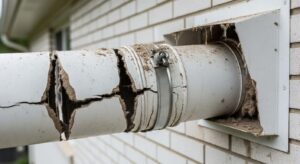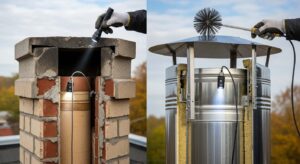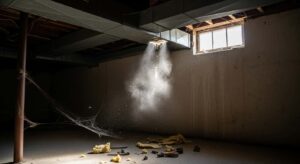As a homeowner, the last thing you need to be added to your plate of never-ending house chores is finding out you’ve got mold hiding away in the corners of your home. Apart from the awful, musty smells and the unsightly black spores on your ceilings and walls, mold is incredibly dangerous for your health. And it’s more often than not lurking in your ductwork.
If you’ve ever run into a similar situation, chances are this is something you don’t want to ignore. You’re also likely to be brimming with questions at this point like does air duct cleaning in NJ get rid of mold? Or is it just a band-aid fix to an issue that runs a lot deeper?
Let’s find out.
What is Mold, and Why Is It So Commonly Found in Your Air Ducts?
Mold is a type of fungus that thrives in damp, dark, and poorly ventilated spaces. Mold spores float around in the air, looking for a nice, moist spot to settle. Once they find one, they grow and spread, sometimes silently, but always causing problems.
Since mold releases toxic substances known as mycotoxins, they’re incredibly harmful, causing various health issues, especially for individuals with allergies, asthma, or weakened immune systems.
Now the term mold is quite broad. You’d actually be thrown back at just how many types of mold air duct cleaners often find in homes.
Here are some of the most common types of mold we come across on a daily:
Different Types of Mold
1. Acremonium
Acremonium can sometimes show up in your ducts, appearing like fine white powder. While it’s not likely to cause any significant health concerns on its own, combine it with other types of mold and you’ve got a completely different story at hand! Which is why, it’s always better to stay on the safe side and keep an eye out for it!
2. Aspergillus
Aspergillus, unfortunately, is one of the trickier molds to identify because it can look so different depending on the situation. It can be green, yellow, white, or a mix of colors.
If you’re unlucky enough to come into contact with it, it can cause symptoms like fever, chills, shortness of breath, and chest or joint pain. Some people also report getting headaches or eye issues when exposed to this mold.
3. Alternaria
Alternaria is another type of mold that can turn up in your air ducts, and it’s actually one of the biggest triggers for allergies. If you’re someone who suffers from them, this mold could definitely make things worse. It can cause everything from sneezing and coughing to itchy eyes and even asthma.
You’ll usually spot it in a green or brown color, and it has a soft, velvet-like texture. This mold tends to appear when there’s a leak in your ducts, which is pretty common in older homes. Another reason you need to get your air ducts cleaned out more often!
4. Fusarium
Fusarium is one of those molds that are actually more common outside, where it grows in soil. But if your HVAC has a leak, you might start seeing it pop up indoors too.
The tricky part with Fusarium is that it can look all sorts of ways. It might be brown, yellow, or white, and its texture can change depending on where it’s growing. The good news, however, is that it’s not a major troublemaker for humans as it is for plants. However, if you’re fond of your greens or have a compromised immune system, you probably want to watch out!
5. Mucor
Take our word for it, you don’t want to mess around with Mucor. It’s pretty dangerous and can cause serious health issues. You’ll typically find it in places like air conditioners and vents, where moisture tends to build up. Your symptoms can vary depending on where the spores end up, but they can get severe.
If you spot some white, yellow, or grey fluffy-looking fungi growing, you need to get on it as quickly as possible.
6. Ulocladium
Ulocladium is one of the rarer molds you might come across, but it can be pretty nasty if you do. It usually shows up in shades of brown, grey, or black and has a texture similar to suede, wool, or cotton.
Unfortunately, it can seriously harm your health. It’s incredibly difficult to get rid of on your own, so make sure to get professional help as soon as possible.
7. Chaetomium
Chaetomium is a mold that looks like cotton and often shows up in air ducts. It’s usually brown, but it can change colors over time, making it a bit tricky to identify. While it can release toxins that are bad for you, it usually just causes skin or nail infections. This mold loves water-damaged areas, so if your HVAC system has a leak, there’s a good chance you’ll find this one in your home.
8. Stachybotrys
If you see a blackish substance in your air ducts, chances are you’ve got Stachybotrys, also known as black mold. Out of all the types of mold on our list, this one is probably the most obvious. It’s literally black and stands out like a sore thumb.
Unfortunately, it’s also one of the most toxic molds you can find. Exposure to Stachybotrys can lead to symptoms like burning or congestion. Some people might even experience headaches, dizziness, or just feel mentally exhausted. So, if you spot black mold in your ducts, it’s a pretty clear sign that something needs to be done, and fast!
Also Read: The Hidden Dangers of Black Mold in Your Ducts
Wondering if Mold’s Hiding in Your Air Ducts? Here’s How to Find Out
Not sure if there’s mold hanging out in your air ducts?
No worries, here are some quick and easy ways to figure it out before you call in the pros for a residential air duct cleaning:
1. Check Your Vents
Take a look at the vents in your walls, ceilings, or floors. If you see dark spots collecting around the edges, it could just be dust. But it might also be a sneaky little mold colony starting up. Either way, it’s worth checking out further.
2. Take a Peek Inside the Vents
Grab a screwdriver, pop off those vent covers, and see what’s going on inside.
If you find a thick layer of dust, dirt, and random debris, it’s a perfect spot for mold to set up shop, especially if there’s any moisture. Mold’s pretty good at finding the right places to grow, so take a good look.
3. Sniff It Out
Before you go all out with a mold test kit, just use your nose. If you catch a musty, funky smell that doesn’t seem to go away, follow that scent!
If you can’t figure out where it’s coming from (and it’s not just the socks you forgot about in the laundry basket), it might be time to call in the experts!
What to Expect: How Does Air Duct Cleaning Work?
If you’re considering air duct cleaning in NJ to deal with mold, it’s important to understand the process so you know exactly what’s involved.
Here’s a breakdown of what to expect during the air duct cleaning process:
1. Inspection
Before anything gets cleaned, the first step is a thorough inspection of your air ducts. This is one of the most important parts of the whole process because it helps the technicians understand what they’re dealing with.
A professional will look for things like:
- Signs of Mold: We’ll check for visible mold growth on the inside of the ducts, registers, and other components. If we suspect mold, we may also take samples to send for testing.
- Amount of Dust and Debris: A major part of air duct cleaning in NJ is removing the build-up of dust, dirt, and allergens, so an inspection will give us a clear idea of how much debris is present.
- Condition of Ducts: We’ll also assess the overall condition of your ducts. We’ll check for things like leaks, damage, or areas where moisture could be accumulating.
2. Vacuuming
Once the inspection is complete, it’s time to start cleaning.
The first step in the cleaning process is vacuuming. But this isn’t just your standard household vacuum. Professional air duct cleaners use high-powered, commercial-grade vacuum systems designed to suck up the dust, dirt, and debris that’s accumulated inside your ducts.
Here’s how it works:
- Negative Pressure: The vacuum creates negative pressure, somewhat like a suction effect inside the ducts, which helps pull out dirt and dust from all areas of the system. The vacuum hose is attached to your ductwork, and this suctioning process pulls dirt into the filtration system.
- Airflow and Reach: Powerful vacuums clean out even the deep, hard-to-reach areas of your ductwork. This is especially important if you have narrow duct systems where debris can build up over time.
The goal of the vacuuming stage is to remove as much loose debris as possible, improving the airflow through your HVAC system. It also helps to reduce mold growth by clearing out material that mold could use as a food source.
3. Brushing
After vacuuming, the next step in the air duct cleaning process is brushing. To get rid of any stubborn dirt and debris that the vacuum couldn’t reach, we use rotary brushes designed specifically for cleaning air ducts.
These brushes are long and flexible, allowing them to scrub the interior of the ducts thoroughly.
Brushing:
- Dislodges stubborn debris: Some dust and debris can become stuck to the walls of the ducts, especially if the system hasn’t been cleaned in a while. The rotary brushes help loosen this material so it can be vacuumed up.
- Scrubs hard-to-reach areas: Air ducts often have twists, turns, and corners where debris can accumulate. The rotating brushes help reach these areas.
4. Sanitization
This step is optional and an extra step professionals offer to help kill bacteria, mold spores, and other pathogens that might be lingering inside the ducts.
Antimicrobial treatments are designed to kill mold, bacteria, and other harmful microorganisms. They’re sprayed into the ducts after vacuuming and brushing, and the idea is to sanitize the system to prevent the growth of mold.
However, there’s a caveat. While these treatments can kill visible mold and spores, they don’t address the underlying cause of mold growth. If there’s still moisture in your ducts or a leak somewhere, mold will likely come back over time, even after disinfecting air ducts.
Also Read: How Much Does Air Duct Cleaning Cost in NJ?
Can Air Duct Cleaning Really Get Rid of Mold?
Okay, now, we get to the meat of the matter: Does air duct cleaning really get rid of mold?
The short answer is: Not always.
When you spot some mold in your home, the most obvious choice you make is to clean it. Right? One swipe, and it’s gone.
But it’s not always as simple as that. While air duct cleaning can help on the surface, it won’t get to the root of the problem, especially if it’s related to moisture or seepage.
What Air Duct Cleaning Can Do
Don’t get us wrong here. Air duct cleaning in NJ, when done right, can make all the difference in the world!
If there’s visible mold or a lot of dust and debris built up in your ducts, cleaning can help clear things out. It’ll improve the air quality, remove dirt, dust, and mold spores, and make your HVAC system run more efficiently.
If the mold problem is relatively minor and surface-level, a professional commercial air duct cleaning might just be what you need to freshen up your space.
What Air Duct Cleaning Can’t Do
Air duct cleaning doesn’t always solve the bigger issue. Mold thrives on moisture, and if there’s an underlying moisture problem in your HVAC system, whether it’s a leak, condensation, or poor insulation, mold is going to keep coming back, even after you’ve cleaned the ducts.
Why You Might Need More Than Just a Cleaning
If you’re finding that mold keeps coming back despite regular cleanings, it might be time to look at the bigger picture. That’s when you might need air duct disinfecting instead of just air duct cleaning.
How Often Should You Clean Your Air Ducts?
The answer really depends on a few different things, but here’s a general guide to help you figure it out:
When You Move In
A good rule of thumb is to clean your air ducts when you move into a new home or office. This is a key time to get rid of any dust, allergens, or even mold that might be in the ducts from previous owners or tenants. Invest in post-renovation air duct cleaning if you’ve just renovated your space.
It’s a fresh start, so why not make sure your air is just as fresh?
General Recommendation
For most homes, getting your air ducts cleaned every three to five years is a solid baseline. But that’s just a general guideline.
Some situations might call for a little more attention.
When You Might Need More Frequent Cleaning
1. High Pollen Levels
If you live in a place where pollen is always floating around, you might want to clean your ducts more often. Pollen can build up fast, and cleaning the ducts will help keep things from getting stuffy and allergens from spreading.
2. Mold Issues
If you’ve had mold in your ducts (or think there’s mold), it’s time to clean those ducts as soon as possible. Mold can grow in moist conditions, so the sooner you deal with it, the better.
3. Pets or Smokers
If you’ve got furry little friends running around or people who smoke indoors, you’ll probably want to clean your ducts more often. Pets shed fur, and smoke particles cling to everything, including your air ducts. More frequent cleanings help keep those musty smells under control.
Why It’s Worth It
Regular air duct cleaning can help improve air quality and keep things fresh. Plus, it can help prevent mold from building up in the system, which can be a bigger problem down the road.

So, while three to five years is a good start, it all comes down to your specific situation. If you’re noticing dust buildup, weird smells, or changes in air quality, it might be time to get those ducts cleaned sooner.
Also Read: What is the Relationship Between Air Duct Cleaning & The Prevention of Mold Growth in HVAC Systems?
Ready to Get Rid of the Pesky Mold?
So, does air duct cleaning in NJ get rid of mold? In many cases, it can help with surface mold and improve your air quality, but it’s not a cure-all. To truly eliminate mold, you need to address the underlying moisture issues that are feeding it.
Dealing with mold in your air ducts doesn’t have to be a headache. At Alpha Clean Air, our air duct cleaning service is specifically designed to tackle mold, leaving your system fresh and your air cleaner.
Give Alpha Clean Air a call today and let us handle the dirty work.!





